The lateral collateral ligament, more commonly referred to as the LCL, is most often injured during contact sports when a direct blow to the inside of the knee stretches or tears the LCL as it is overextended on the outside of the knee. Injury to this ligament is much less common than to the medial collateral ligament (MCL) located on the inside of the knee joint. This is because the lateral collateral ligament is on the outside of the knee and the opposite leg often protects the inner knee from a blow or any trauma. As a result, most LCL injuries occur when the leg is outstretched in front of the body and the inner knee is left unprotected by the other leg.
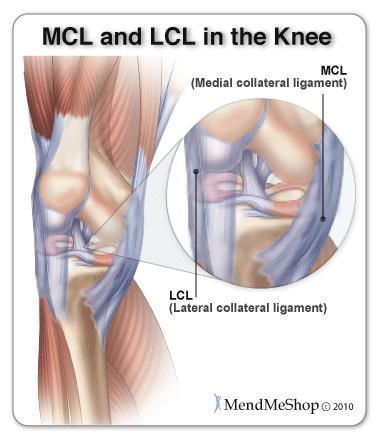
The knee has 2 collateral (parallel) ligaments and 2 cruciate (crossing) ligaments. The medial collateral ligament (MCL) and the lateral collateral ligament (LCL) provide support to the knee by limiting the sideways motion of the joint. The anterior cruciate ligament (ACL) and the posterior cruciate ligament (PCL) bond the upper and lower parts of the leg together and stabilize the knee by limiting the rotation and the forward and backward movement of the joint.
The Lateral Collateral Ligament is a round ligament located on the outside of the knee that lies beneath the tendon of the biceps femoris muscle.
This ligament joins the end of the fibula, which is located on the outside of the tibia (shin bone), and the bottom outside surface of the femur (thigh bone). Unlike the MCL, the LCL is not attached to either menisci in the knee and therefore, the menisci usually remain undamaged when the LCL is torn or stretched. The LCL becomes taut when the knee is extended and acts to stabilize the outside of the knee joint.
Sufferers of an LCL stretch or minor tear will experience mild tenderness with little swelling on the outside of the knee. More severe tears or ruptures result in pain directly over the ligament along the outside of the knee. Swelling is common and locking or catching of the knee may occur with movement and bending. Bruising will often appear 1-2 days after the injury occurs. A tear in the LCL ligament may also make the knee feel unstable or loose.
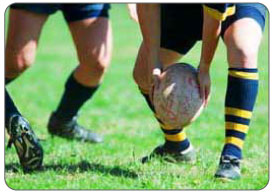
An injury to the Lateral Collateral Ligament occurs when there is a stretch, partial tear, or complete tear (rupture) to the ligament.
A blow to the inside of the knee during any number of contact sports is usually the cause of this injury. The force to the inside of the knee joint pushes the knee outward resulting in stress being placed on the ligament on the outside of the knee joint, the LCL. This stress or overextension causes the stretch or tear.
It is also possible that an injury to the LCL will occur in conjunction with injury to other ligaments in the knee depending on the amount of force the knee experiences.
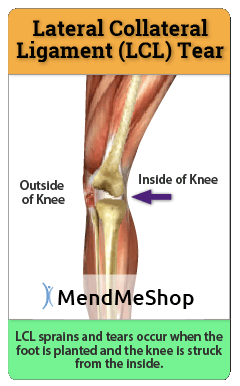
To diagnose an LCL tear and the extent of damage that has occured, your doctor will perform a variety of assessments:
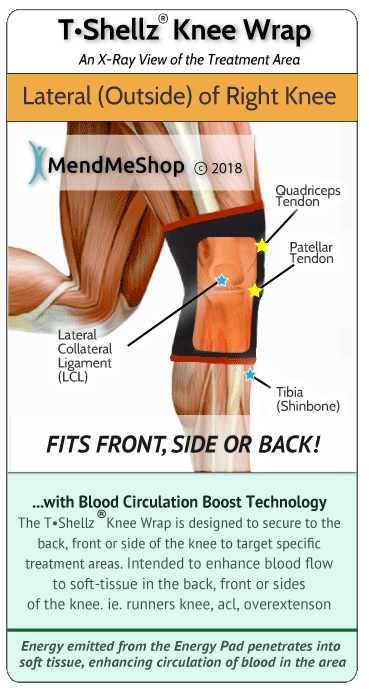
Like most sprains or tears to a ligament, immediate treatment of the LCL injury includes the application of cold compression, rest and elevation of the knee. It is also important to allow the injured knee to rest.
Treatment differs from case to case depending on the degree of instability in the knee and the patients activity level. Treating an LCL injury with rest, cold, and Circulation Boost will speed healing and improve the function of the knee so you can return to your normal activities quickly. Once the LCL has improved and activities can be resumed, you will first want to build muscle strength around the knee under the guidance of a physical therapist.
In cases of a complete rupture of the LCL, reconstruction/reattachment of the LCL will be required. Using these therapies prior to surgery will reduce further damage and improve the health of the surrounding tissue so the surgery will be less invasive. Generally, the more invasive the surgery, the more scar tissue is introduced into the area.
Using the following therapies after surgery will control pain and swelling, reduce tissue damage, speed healing and treat the scar tissue resulting from the healing process. You will have a healthier knee with a greater range of motion than if your reconstructed LCL was left untreated.
Resting the injured knee (meaning don't use it at all!) helps prevent the injury from worsening. Not resting a soft tissue injury is dangerous, as this will increase the risk of re-injury and increased swelling - eventually this will become chronic. The quickest (and safest) way to repair damaged soft tissue at home is to rest and incorporate the use of TShellz Knee Wraps at least twice per day .
Using cold compression immediately following an LCL tear reduces pain and swelling and reduces the tissue damage that occurs with soft tissue injuries like ligament tears. A Cold Compress or Ice Pack allows you to treat yourself in an effective and convenient way following an LCL tear, if re-injury occurs (which is common due to the instability of the knee), or following surgery if it is required.
Cold works by interrupting and slowing nerve and tissue function in the damaged area. This is important because once blood vessels are damaged, they can no longer carry oxygenated blood to the damaged LCL so this tissue begins to break-down.
Once the inflammation and swelling of an LCL tear has been alleviated, nourishing and strengthening the ligament tissue is recommended. Using Circulation Boost will speed your recovery and heal your ligament more completely preparing it for leg strengthening exercises. Talk to your doctor or physical therapist to find out which exercises are appropriate for your situation.
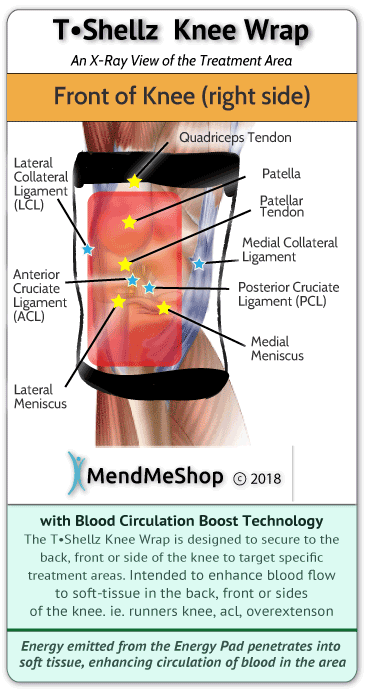
After initial inflammation and swelling is gone you can begin to treat your LCL tear with Circulation Boost, or Circulatory Boost. Circulatory Boost increases the amount of blood that flows naturally to your knee to nourish cartilage, tendons, ligaments and muscles to speed healing.
The use Circulation Boost (Circulatory Boost), will speed your recovery and heal your injury more completely preparing it for strengthening exercises. Circulatory Boost increases the amount of blood that flows naturally to your soft tissue to nourish your tendons, ligaments and muscles, improving elasticity and increasing the healing process. This increased Circulation Boost to your tendon or muscles is greatly needed.
Using the TShellz Wrap® is truly a unique experience. Within moments of applying a TShellz Wrap® to your knee, you can feel the healing sensation due to the increase in blood flow deep within the area. During a treatment, and for quite some time after you finish, your injured knee tendons, ligaments, bursa and muscles will feel gently warmed and more relaxed. It's a very soothing sensation and extremely effective.
By treating yourself with Circulation Boost you can increase your body's blood supply to the knee and your body's natural healing power. In addition, the fresh blood flow whisks away dead tissue and toxins that have built up from the injury leaving the area clean and able to heal faster. Our Knee TShellz Wrap® provides effective, non-invasive, non-addictive pain relief and healing with no side effects.
Continue the healing process by resting your injury. Limit your movements that may aggravate your strain and lead to reinjury. Tendon / Muscle related injuries can easily turn from a grade 1 strain into a grade 2 or a grade 2 into a grade 3 injury.
During your recovery, you will probably have to modify and/or eliminate any activities that cause pain or discomfort in your knee until your pain and inflammation settle. Taking the time to care for your knee properly will have your knee back to normal faster and allow you to get back to the activities you enjoy.
The more diligent you are with your treatment and rehabilitation, the faster you will see successful results! Through use of controlling inflammation with cold and treating the injured area with a Knee TShellz Wrap®, you will notice incredible improvement in your knee.
If an injured ligament does not strengthen appropriately or an athlete continues to experience the knee giving way, arthroscopic surgery and ligament reconstruction may be necessary.
If LCL reconstructive surgery is necessary, remember that proper post-surgery rehabilitation is very important, perhaps even more important than the surgery itself.
Activities should set out to promote healing, increase flexibility in the knee and strengthen surrounding muscles. Your physical therapist will probably set up a "passive range of motion" program, and put you in a hinged knee brace for a month or two to prevent hyper-extension or hyper-flexion in the knee.
An important point for LCL patients to remember after surgery is that every effort must be made to increase range of motion and flexibility at the knee. Weakness in the knee can usually be eliminated by extra strengthening exercises, but increased stiffness can sometimes be permanent if not corrected by further surgery.
Not only will the Knee TShellz Wrap® help reduce the pain and inflammation in your knee, but will help increase the range of motion in your joint, reduce post operative scar tissue and increase flexibility in the surrounding muscles, tendons and ligaments.
Ask your physical therapist about these treatments and if it's right for your reconstructed LCL! As with all medical devices, make sure your physician is aware of any treatment plan you decide to take.
The growth of scar tissue and adhesions are a big problem when recovering from most knee surgeries. Scar tissue/adhesions are what cause stiffening in the tendons and muscle, entrapping nerves, restricting movements, and reducing blood flow.
Unfortunately, scar tissue does not "just go away". Depending on your activity level, age, and therapy done during your rehabilitation, it may never go away. Scar tissue is a major problem as it will permanently reduce flexibility and vastly increase your risk of re-injury. When dealing with scar tissue it is always important to:
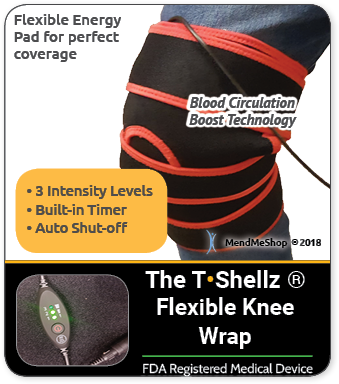
To prevent knee injuries it is recommended that you gradually increase the intensity of any exercise or activity when you begin and to be aware of the movement of the knee during activity.
A knee that is supported by strong leg muscles is less prone to injury, therefore, regular exercise and maintaining good physical condition, particularly when participating in sports such as football and skiing are also excellent ways to avoid ligament injuries. If your knee is unstable or weak, wearing a brace during exercise and activity can reduce the risk of re-injury of the ligament while your knee is regaining strength.
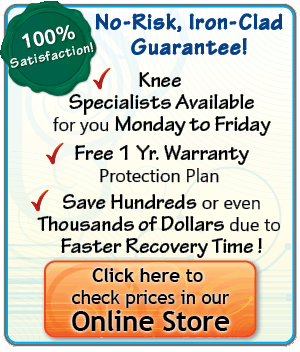
Giving yourself a T•Shellz Treatment will help increase elasticity of soft tissue (via warming) and stimulate your blood cirulation in the treatment area. As such, the use of a TShellz Wrap® is recommended before exercise or strenuous activity as it will help prevent further strain or reinjury due to increased tissue flexibility.
It may seem hard to believe, but our TShellz Wrap® will assist you in recovering from your injury faster and reduce the chance of degenerative conditions by maximizing blood flow where it is needed most, reduce swelling and inflammation induced pain.
If you want to prevent further damage to your knee injury, heal more quickly, reduce swelling and increase circulation for lifelong health benefits, proper use of an ice pack and a Knee TShellz Wrap® will provide exceptional results. Why spend time in pain, off from work, and missing out on your active lifestyle when you can be proactive about your injury and the health of your body? Talk to your doctor about incorporating a regular routine of using Circulation Boost into your everyday health regimen.
Our customer service lines are open 5 days a week helping people understand their injuries and how to treat them. Simply call toll free 1-866-237-9608 to talk with one of our knowledgeable Product Advisors. They have the ability to answer questions and even put together a treatment plan for you.
Product Advisors are available 9:00 am to 5:00 pm Eastern Standard Time Monday to Friday.
Learn more about Knee Surgery and Post-Surgery Recovery
Learn more about how the TShellz Wrap® stimulates blood flow.
Learn more about Ice vs Heat Treatments for Knee Strain
During your recovery, you will probably have to modify and/or eliminate any activities that cause pain or discomfort at the location of your soft tissue injury until the pain and inflammation settle. The more diligent you are with your treatment and rehabilitation, the faster you will see successful results!
Please be aware that this information is neither intended nor implied to be a substitute for professional medical advice. CALL YOUR HEALTHCARE PROVIDER IMMEDIATELY IF YOU THINK YOU MAY HAVE A MEDICAL EMERGENCY. Always seek the advice of your physician or other qualified health provider before using any of our outstanding products to make sure they are right for you and your condition or if you have any questions regarding a medical condition. Always see your doctor for a proper diagnosis as there are often many injuries and conditions (some very serious) that could be the cause of your pain.
© 2025 In.Genu Design Group, Inc. Contact Us